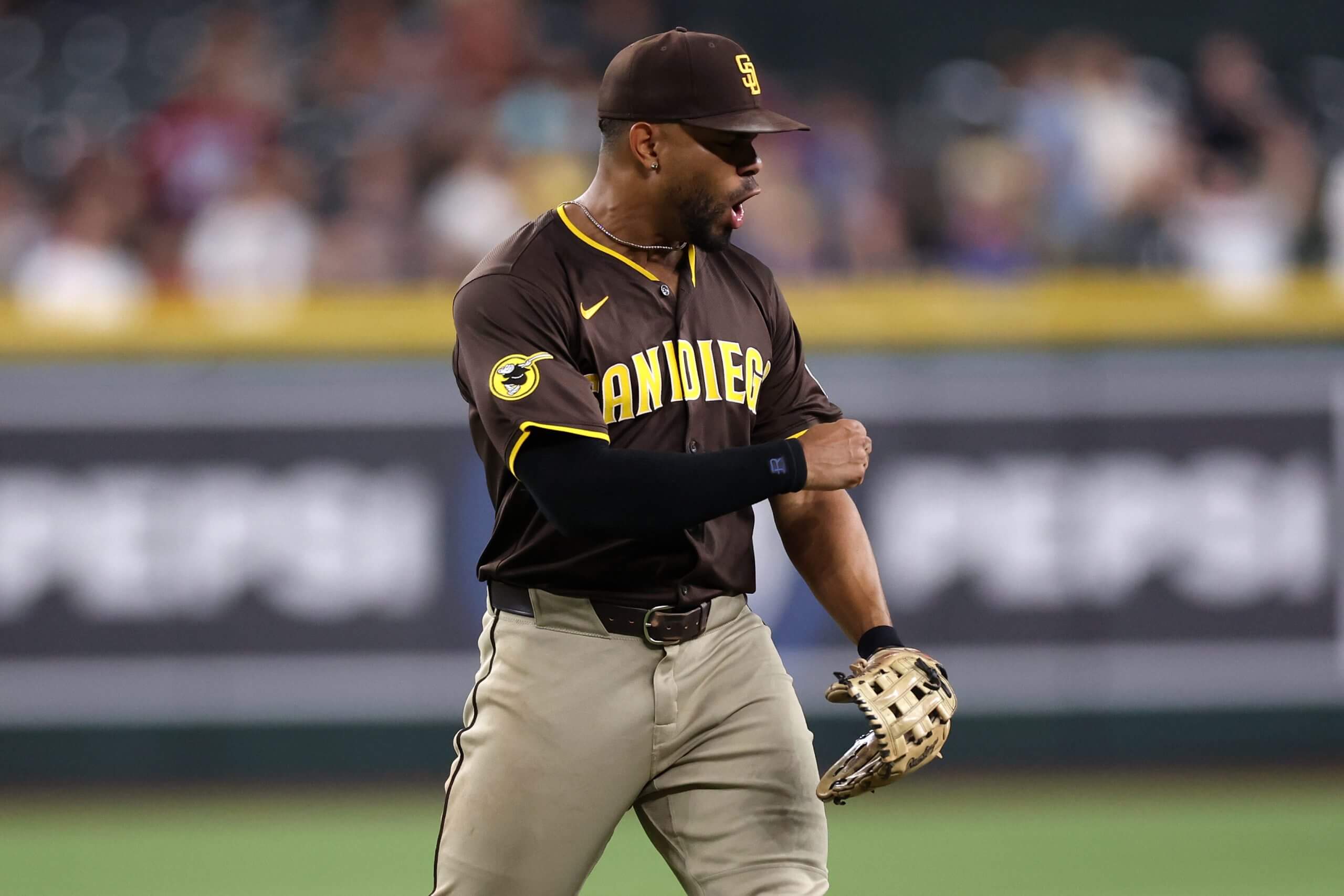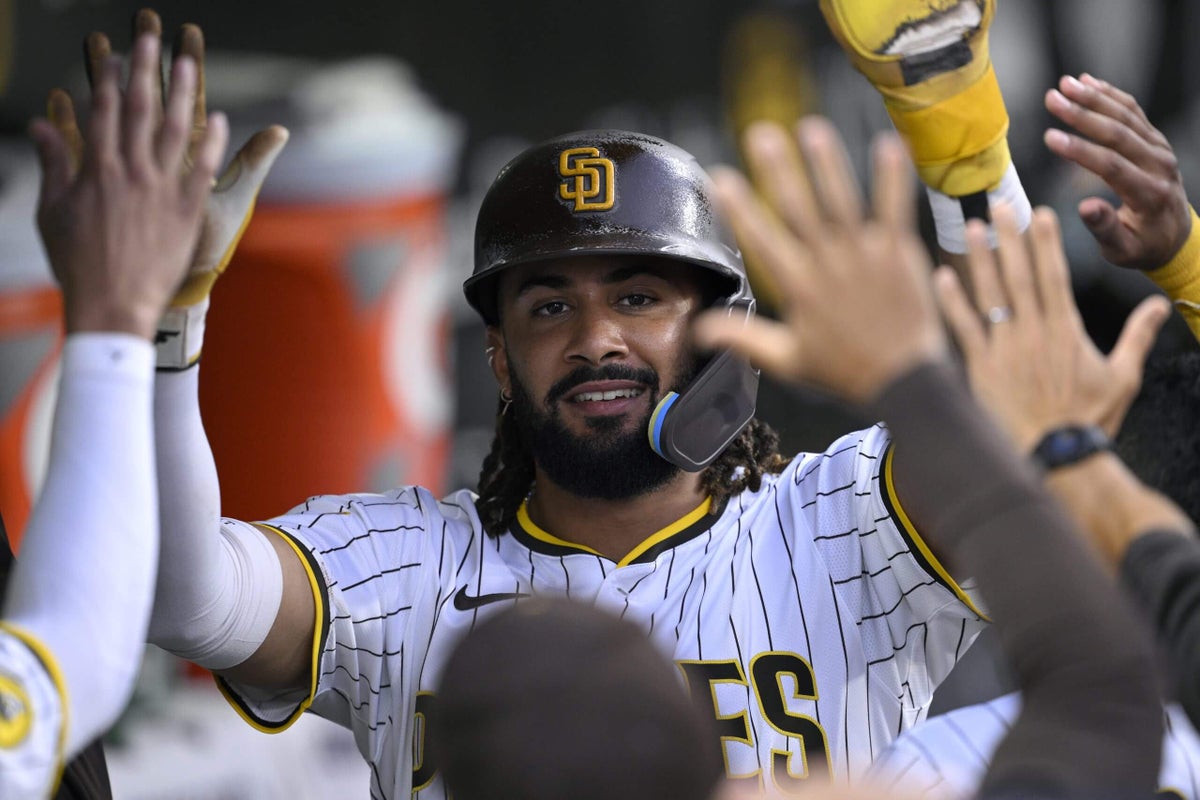SAN DIEGO — Six weeks ago, after returning home from a frustrating road trip, the Padres awoke on the fringes of wild-card contention. They were 46-40. Their odds of making the postseason, according to FanGraphs, were at a little more than 40 percent. The site’s projections gave them less than a 1 percent shot of winning the National League West.
That owed to the continued dominance of their chief rivals.
That night, the Los Angeles Dodgers finished off a seventh consecutive winning series and moved to a season-high 24 games above .500. They appeared to be cruising toward a 12th division crown in 13 years. Despite a slew of injuries, their World Series title defense was more or less going according to plan.
The Padres have since won 23 of 35 games. The Dodgers have lost 21 of 33 — and now trail San Diego by a full game. Friday at Dodger Stadium, the two teams will meet in the first of consecutive weekend series against each other. It’s still August, but the stakes should impart the feel of October.
The last time the Padres were alone in first place this late in a season? Sept. 25, 2010, with current Chicago White Sox manager Will Venable batting leadoff.
The last time the Padres won the division? The final day of the 2006 regular season, with current Dodgers manager Dave Roberts batting leadoff. (The Padres and Dodgers finished with identical records, but San Diego captured the division because it won the season series.)
Almost two decades later, the Padres are threatening to end the Dodgers’ reign over the NL West. How, against the odds, did they reach this point? Here are five numbers that tell the story of a midsummer surge.
2.05 ERA: The San Diego bullpen’s mark over the past six weeks
Jeremiah Estrada, in his second full season, has a 0.51 ERA since July 3. Rookie David Morgan has a 1.20 ERA in the same span. Among the Padres’ six highest-leverage relievers, these are the only two who have not gone to an All-Star game since the start of 2024. Even veteran Wandy Peralta, who isn’t a member of that vaunted group, has a 2.12 ERA over the past six weeks.
And, over the past six weeks, no bullpen has a better ERA than San Diego’s. For the season, the Padres continue to lead the majors in relief ERA (2.97). Meanwhile, the Dodgers rank 20th with a 4.22 ERA from a bullpen that has shouldered the league’s heaviest workload since the start of last October.
Padres relievers, conversely, are spreading shutdown innings around. Morgan’s emergence and the aggressive acquisition of Mason Miller have facilitated more rest for Estrada, Adrian Morejon, Jason Adam and Robert Suarez. Saturday against a good Boston Red Sox offense, the latter five relievers combined for six innings and 13 strikeouts. Less than 24 hours later, Adam, Morejon and Morgan teamed up for three scoreless innings and six strikeouts in a series-clinching win.
No club looks better-equipped to shorten games, now or in October.
5.33: Runs per game by the Padres offense since the trade deadline
That’s up from 4.08 runs per game before the Padres acquired Ramón Laureano, Ryan O’Hearn and Freddy Fermin on deadline day. This month, a newly lengthened offense ranks sixth in the majors in runs scored.
If weaknesses remain, they are not obvious. The Padres’ only starters with a sub-.800 on-base plus slugging percentage in August are the top three hitters in the lineup: Fernando Tatis Jr. (.679), Luis Arraez (.583) and Manny Machado (.631). Meanwhile, Laureano (1.000) and Fermin (.878) are flourishing in a new environment. O’Hearn (.676) has played more sparingly but also delivered multiple key hits. Gavin Sheets (.804) has gone from playing almost every day to serving as one of the league’s better bench bats.
Almost all of these hitters contributed in Wednesday’s 11-1 shellacking of the San Francisco Giants. (Fermin received a day off, and with the score lopsided, Sheets’ services were not required.) It was the kind of performance that often felt unattainable while the Padres still employed Yuli Gurriel, Jason Heyward and Martín Maldonado — three respected veterans whose big-league careers might be done.
Does the upgraded Padres lineup have the edge over a Dodgers offense led by Shohei Ohtani? It’s debatable, but San Diego at least is not stuck paying $17 million to Michael Conforto; the Los Angeles outfielder has continued starting most games despite below-replacement-level production.
14.5 percent: Dylan Cease’s curveball usage over two August starts
The Padres considered trading Cease all the way up until the July 31 deadline. They didn’t ultimately trade him. It could end up being their best move — or non-move — of the summer.
Across his first 22 starts, Cease compiled a disappointing 4.79 ERA while throwing his knuckle-curve just 6.8 percent of the time. Since the deadline, he has more than doubled his usage of that pitch. The increased variety has helped an inconsistent, sometimes-dominant righty string together two of his best outings of the year. In that 11-inning stretch, Cease allowed two runs and struck out 16. The Padres won both games by a comfortable margin.
This version of Cease could elevate the Padres in September and beyond. He tends to work fewer innings than Nick Pivetta or the healthy versions of Michael King and Yu Darvish, but Cease possesses the kind of swing-and-miss stuff that should play especially well in the postseason.
It hasn’t yet; Cease owns a 12.91 ERA in four career postseason outings. The pending free agent is motivated to change that, and an elite bullpen could ease at least some of the pressure.
5th: Xander Bogaerts’ rank, among all major-league hitters, in WAR over the past eight weeks
On June 18 at Dodger Stadium, Bogaerts laced a tying double in the top of the ninth. Later, after a walk-off loss, he lamented that he was still failing to provide enough production. At the time, the $280 million shortstop ranked 109th among qualifying players with 0.7 WAR, according to FanGraphs. The majority of that value had come through his defense.
Bogaerts has since been one of the most productive players in baseball. His 2.3 WAR over the past eight weeks is fifth most among major-league hitters — one spot ahead of Ohtani, the NL home run leader. Bogaerts is still playing solid defense and still stealing bases, but he’s also gone from an offensive liability to a middle-of-the-order asset. Since June 19, he has hit .326 with a .908 OPS.

Xander Bogaerts has quickly gone from a net negative to a massive positive for the surging Padres. (Chris Coduto / Getty Images)
And it’s not as if a previously unlucky hitter is getting especially lucky. Entering Wednesday, Bogaerts’ batting average was 11 percentage points lower than his expected batting average. His slugging percentage was 24 percentage points lower than his expected slugging percentage. Scouts say Bogaerts, 32, looks more athletic than he did early this season.
He might never again be an All-Star, but with Tatis and Jackson Merrill still searching for past offensive form, Bogaerts has buoyed the Padres for weeks.
6: The number of big-league players acquired by the Padres at the trade deadline
Elsewhere, the Dodgers acquired Alex Call and Brock Stewart, the latter of whom landed on the injured list this week. Their modest approach to the deadline was not without logic; Los Angeles, after another offseason of extravagant spending, is counting on its depth, improved health and increased production from some underperforming stars.
And as wild as A.J. Preller’s day was, the Padres general manager also made understandable moves while working with payroll constraints. Four of San Diego’s big-league additions are controllable beyond this season, but there was no mistaking the intent: With their veterans not getting any younger, and several key contributors heading toward free agency, the Padres are all in on this October.
(Top photo: Orlando Ramirez / Getty Images)
